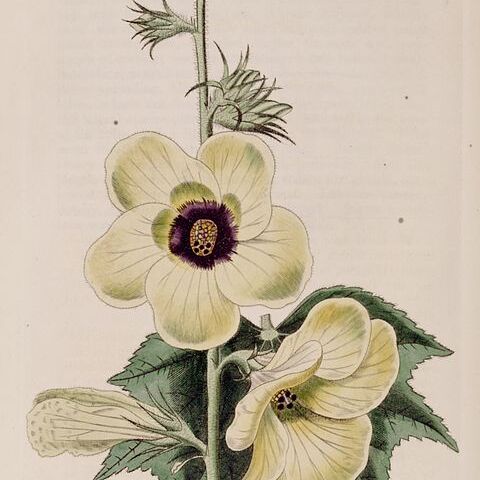Herbs perennial, 0.5-2 m tall, entire plant long yellow setose (hairs 5-6 mm) and minutely gray puberulent. Stipules filiform, 1.5-4 cm; petiole 4-12 cm; leaf blades on proximal part of stem orbicular, ca. 9 cm in diam., 5-lobed, those on mid stem cordate, those on distal part of stem sagittate, 4-15 cm, hirsute with long hairs on both surfaces, sparsely hispid or stellate hispid with long hairs on veins. Inflorescences terminal or axillary, a 3-9-flowered raceme. Pedicel 1-1.5(-2.5) cm. Epicalyx lobes 10-20, filiform, 10-35 × 1-2 mm, densely yellow, long hirsute. Calyx spathaceous, longer than epicalyx, simple-pubescent, also yellow setose toward apex, lobes linear. Corolla yellow, ca. 13 cm in diam.; petals 5-8 cm. Staminal column ca. 2 cm. Style branches 5; stigma flat. Capsule subglobose, 3-4 × ca. 3 cm, densely hirsute with yellow and long hairs. Seeds many, reniform, verrucose. Fl. May-Sep.
More
A herb. It keeps growing from year to year. It is 0.5-2 m tall. It has a tuber-like taproot. The whole plant has long yellow hairs. These can be prickly. The leaf stalk is 4-12 cm long. The leaf blade varies in shape. The lower leaves are round and about 9 cm across with 5 lobes. The leaves in the middle are heart shaped and those at the top have long pointed bases. These ones are 4-15 cm long. The flowering stalks are at the end of the branches or in the axils of leaves. There are 3-9 flowers in a group. The fruit is a half round capsule. It is 3 cm across. There are many kidney shaped seeds inside.
Can be grown by seedlings. Seeds needs soaking.


